SPECTRA OF PECULIAR STARS
Wolf-Rayet stars
The stars that belong to WR class were discovered by french astronomers C.J. Wolf e G. Rayet in 1867
when they found that some stars in Cygnus (V1042, MR103, MR100) show broad emission lines.
The majority of WR stars are in Cygnus (they have a galactic distribution similar to O and B stars) but
they are fainter than mag 7.5. The only naked eye WR star is g Velorum,
(mag 1.74, type WC8+O9) whose spectrum was first observed by Respighi in 1871.
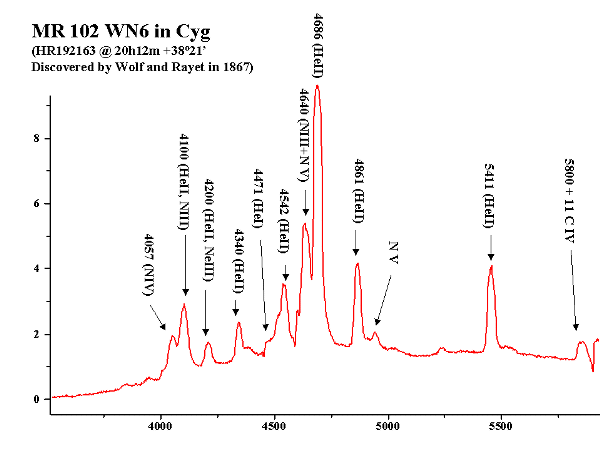
|
|
Picture 1: Spectrum of WR star HR192163 belonging to the subtype nitrogen rich.
The spectrum was recorded with a 900 l/mm grating with a 2 ┼ spectral resolution.
Spectrum is not corrected for spectrograph sensitivity and atmospheric transparency.
|
From the spectroscopic viewpoint, WR stars are divided into two main subtypes: WN are nitrogen rich and WC are carbon rich.
Each subtype is divided in subclasses (WN goes from WN3 to WN8 and WC from WC5 to WC9) depending on the temperature
that can be deduced fron the ionisation state of nitrogen and carbon.
Due to the high temperature of these stars, ionized helium lines are always observed together with
carbon and nitrogen. Ionized helium lines appear at the same position of hydrogen lines divided by four,
due to the +2 charge in the He+ nucleus.
As an example, lines that seems due to hydrogen balmer lines in WR spectra, are infact due to
Brackett series (n1=4 and n2= 6, 7, 8, 9) of He+. He+ can be distinguished from hydrogen
from the 4685 ┼ line that belongs to the Paschen series (n1=3, n2=4)and do not overlap any hydrogen existing wavelenght.
Broadening of spectral lines are generated by furious outward matter flows that ejact in space some
1/10000 solar masses per year (for comparison, sun loses only 10-15 solar masses per year).
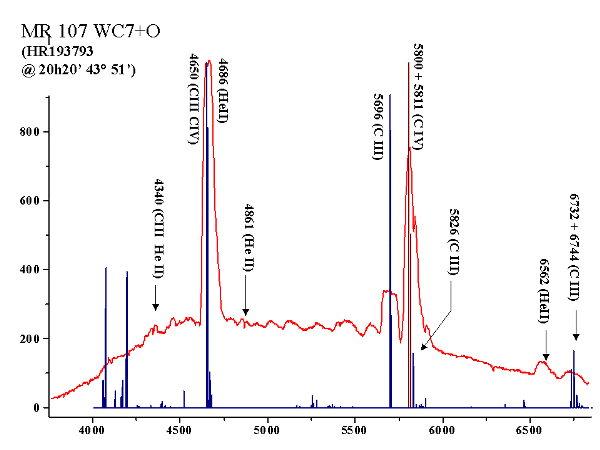
|
|
Picture 2: Spectrum of WR carbon rich star HR193793 in Cygnus.
(600 l/mm grating with 2.5 ┼/pixel dispersion, exposure 2 min with 0.6 m reflector).
The spectrum is not corrected for the athmospheric transmission and spectral sensitivity of grating and CCD.
The narrow blue lines are produced simulating the emission spectrum of C III starting from the atomic data tables of NIST, while
the brown narrow lines represent simulation of C IV in the same way. The identification of the main emission features with C III or C IV is
straightforward.
|
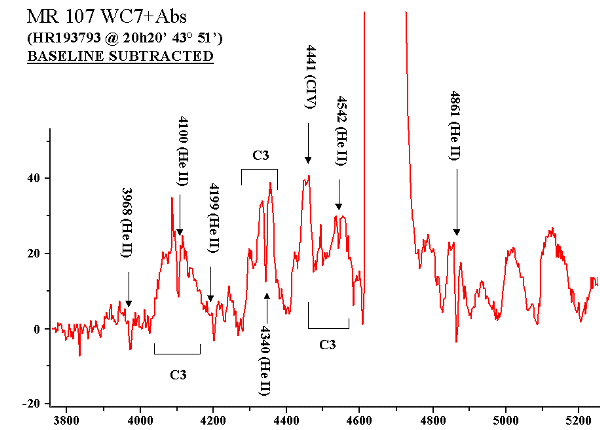
|
Picture 3: Enlargement of spectrum of picture 2 (WRC star HR193793) .
In addition to emission lines, it can be observed a continuum with He II absorption lines that are typical of O class.
It could well be the spectrum of a less evoluted companion. About 37% of WR stars belongs to binary systems and the companion
is always a massive O or B star.
|
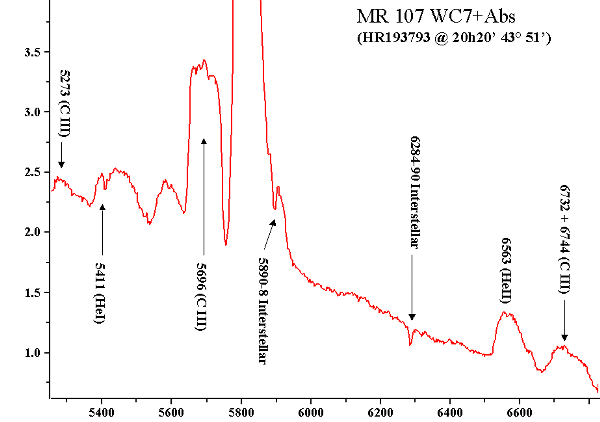
|
Picture 4: Enlargement of spectrum of picture 2 (WRC star HR193793) .
In addition to emission lines, it can be observed a continuum with He II absorption lines that are typical of O class.
|
Wolf-Rayet stars are very hot, with temperatures ranging between 30000 and 90000 K and the most recent theories consider these stars as
the evolution of massive stars of O and B type with mass exceding 40 solar masses with chemical abundancies close to those of our sun.
Population I O and B stars haven't evolved in the past into WR stars because they have not enough metals and thus too low opacity that cannot produce the furious stellar winds that are observed.
In few million years these giant stars burn all the hydrogen in their core and then start to cool down moving horizontally throught the HR diagram into G and F classes until they arrive to the red giants region.
At this step convection starts and, together with strong stellar winds, bring to the surface the products of the hydrogen fusion, mainly Helium but also Nitrogen, produced by partial fusion of He. The star enter the WR-N early classes and its mass has in the meanwhile decreased to 30 solar masses.
After the hydrogen, in the core starts the burning of He into Carbon and Oxigen and in the surface the hydrogen is transformed in He and Nitrogen via the CNO cycle. The CNO process maintai constant the N/C ratio for about 200'000 years. The spectrum is now typical of a late WR - N, like the one of picture 1, wit a little carbon but still mainly nitrogen.
When the CNO process is over at the surface, the atmosphere become more and more rich in carbon, because it continues to come up from the inner shells where helium is still burning. In the meanwhile, without the CNO stabilisation, the nitrogen combine with helium to give oxygen. The spectrum is now of the WR - C type, like the one that is shown into the pictures 2 to 4.
In the next step, also the carbon is transformed into oxygen combining with helium and the spectrum shows mainly bands of highly ionized oxygen. The very few stars that show this behaviour are ranked as WR - O.
In the meanwhile the mass has decreased to 10 solar masses and the star is probabably preparing to explode as a Ib supernova.
In the following table are listed someof the WR stars that are easier to observe from the northern emisphere.
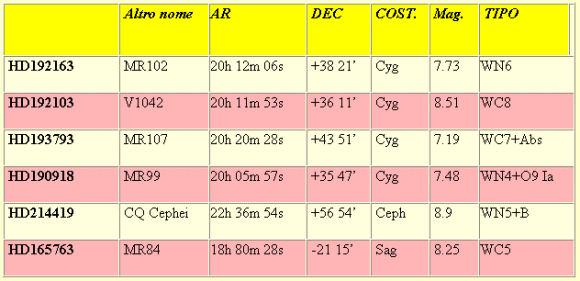
 Go back to the Home Page of Peculiar Stars Go back to the Home Page of Peculiar Stars
|
|

 Go back to the Home Page of Peculiar Stars
Go back to the Home Page of Peculiar Stars




